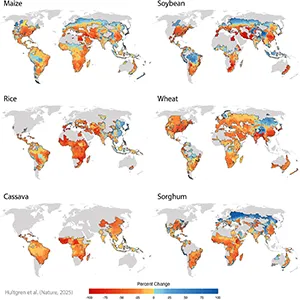A lifetime of learning: Dorothy Helema’s journey with Conservation Agriculture in Malawi – CIMMYT

Report on Conservation Agriculture Implementation and its Alignment with Sustainable Development Goals in Salima District, Malawi
1.0 Introduction and Executive Summary
This report details the long-term implementation of Conservation Agriculture (CA) in Chinguluwe, Thuphwi Village, Salima District, Malawi, centered on the work of farmer and trial implementer, Dorothy Helema. Her consistent and precise application of CA principles provides a compelling case study on sustainable agricultural intensification. The initiative, a collaboration between local farmers, the International Maize and Wheat Improvement Center (CIMMYT), and Total LandCare, demonstrates significant contributions towards several United Nations Sustainable Development Goals (SDGs). Ms. Helema’s work serves as a benchmark for scaling climate-resilient farming practices, directly impacting food security, gender equality, and environmental sustainability.
The project’s success illustrates a powerful model for achieving the following key SDGs:
- SDG 2 (Zero Hunger): By significantly boosting crop yields, improving soil fertility, and enhancing household nutrition through crop diversification.
- SDG 5 (Gender Equality): By empowering a female farmer to become a respected community leader, mentor, and key research collaborator.
- SDG 13 (Climate Action): By implementing agricultural systems that build resilience to climate variability.
- SDG 15 (Life on Land): By promoting practices that halt and reverse land degradation and improve soil health.
- SDG 17 (Partnerships for the Goals): Through the effective collaboration between research institutions, NGOs, and local farming communities.
2.0 Project History and Collaborative Framework
2.1 Origins and Legacy
The initiative began in 2008 when Christopher Helema, Dorothy Helema’s late husband, participated in a cross-site learning visit facilitated by CIMMYT and Total LandCare. Inspired by the potential of CA, he became a lead trial implementer in his village. Following his passing, Dorothy Helema continued the work, transforming the trial plots into a model of excellence and ensuring the continuity of this vital research. Her sustained commitment exemplifies how individual dedication can anchor long-term development projects and drive community-level innovation, a core tenet of SDG 17 (Partnerships for the Goals).
2.2 Role of Dorothy Helema as a Model Farmer
Dorothy Helema has transitioned from a participant to a central figure in the local agricultural ecosystem. Her role encompasses:
- Trial Implementer: Maintaining research plots with high precision, providing reliable long-term data for agronomists.
- Community Mentor: Acting as a peer educator and local champion for sustainable practices, influencing the adoption of CA by other farmers.
- Female Leader: Serving as a powerful example of female leadership in agriculture, directly contributing to SDG 5 (Gender Equality) by challenging traditional gender roles and demonstrating women’s capacity as innovators and community pillars.
3.0 Conservation Agriculture Systems and Contribution to SDGs
3.1 Core CA Principles and Alignment with SDG 15
The trials implemented by Ms. Helema are founded on the three core principles of Conservation Agriculture, which directly support SDG 15 (Life on Land) by improving soil structure, fertility, and water retention.
- Minimum Tillage: Reducing soil disturbance to preserve soil structure and organic matter.
- Permanent Soil Cover: Utilizing crop residues (residue retention) to protect the soil from erosion and reduce water evaporation.
- Crop Diversification: Employing intercropping and crop rotation to enhance soil fertility, break pest cycles, and improve system resilience.
3.2 Evolution of Cropping Systems for Multiple SDG Benefits
The trial has evolved from a simple system to a complex, diversified model, demonstrating a pathway to achieving multiple SDGs simultaneously.
- Maize-Only System: The initial entry point focused on improving yields of the primary staple crop.
- Introduction of Legume Intercrops: Cowpeas were integrated to diversify the system, improve soil nitrogen, and build resilience, contributing to SDG 2 (Zero Hunger).
- Integration of Rotational Crops: Groundnuts were introduced, adding further nutritional benefits and creating new income streams, thereby addressing SDG 1 (No Poverty).
- Adoption of Improved Varieties: Stress-tolerant maize varieties were introduced to maximize the benefits of improved soil health and build resilience against climate shocks, a key target of SDG 13 (Climate Action).
- Doubled-Up Legume Systems: The current system involves rotating maize with a pigeon pea and groundnut intercrop, which maximizes soil fertility benefits while further diversifying household income and nutrition.
4.0 Quantifiable Impacts and Scaling Potential
4.1 Yield Improvements and Food Security (SDG 2)
The results from Ms. Helema’s plots provide quantitative evidence of CA’s effectiveness. During the 2024/2025 season, her maize-legume rotation plots yielded 5,382 kg/ha, a figure substantially higher than local and national averages. This demonstrates a direct and measurable contribution to SDG 2 (Zero Hunger) by increasing food availability and security at the household and community levels.
4.2 Knowledge Diffusion and Scaling for Impact (SDG 17)
Ms. Helema’s fields function as a de facto demonstration hub, facilitating peer-to-peer learning and organic diffusion of CA technologies. This model, where “people scale technologies,” is central to the mission of the CGIAR Initiative on Scaling for Impact. To replicate this success, sustained investment is required in:
- Field staff and extension services.
- Knowledge-sharing platforms.
- Gender-sensitive extension models that empower more women like Dorothy Helema.
- Long-term partnerships that track and support agricultural transformation over time.
By investing in these areas, the impact seen in Thuphwi Village can be scaled to advance the Sustainable Development Goals across Malawi and other regions facing similar challenges.
Analysis of Sustainable Development Goals in the Article
1. Which SDGs are addressed or connected to the issues highlighted in the article?
The article highlights several issues that are directly connected to the following Sustainable Development Goals (SDGs):
- SDG 1: No Poverty. The article touches upon improving livelihoods by diversifying income sources for farmers through the introduction of various crops like groundnuts, which have market value.
- SDG 2: Zero Hunger. This is a central theme. The article focuses on increasing food production, improving nutrition, and promoting sustainable agriculture. It discusses boosting maize yields, enhancing household nutrition with legumes, and ensuring long-term food security through resilient farming practices.
- SDG 5: Gender Equality. The narrative is built around Dorothy Helema, a woman who took over her late husband’s role and became a respected leader, mentor, and expert in Conservation Agriculture in her community. This showcases female empowerment and leadership in a traditionally male-dominated field. The article also calls for “gender-sensitive extension models.”
- SDG 8: Decent Work and Economic Growth. By promoting farming practices that increase yields and diversify income, the article addresses the economic empowerment of smallholder farmers, contributing to local economic growth.
- SDG 9: Industry, Innovation, and Infrastructure. The article emphasizes agricultural research, innovation, and the development and scaling of new farming technologies and systems, such as the evolution from simple maize plots to complex doubled-up legume systems.
- SDG 13: Climate Action. The promotion of Conservation Agriculture, with its focus on building resilience, using stress-tolerant crop varieties, and adapting to changing “rainfall patterns,” directly addresses the need for climate adaptation in agriculture.
- SDG 15: Life on Land. The core principles of Conservation Agriculture discussed—improving “soil fertility,” enhancing “soil health,” and practicing crop rotation—are fundamental to combating land degradation and promoting the sustainable use of terrestrial ecosystems.
- SDG 17: Partnerships for the Goals. The article explicitly mentions the collaborative efforts between international research institutions (CIMMYT, CGIAR), NGOs (Total LandCare), and local farmers like Dorothy, highlighting the importance of multi-stakeholder partnerships to achieve sustainable development.
2. What specific targets under those SDGs can be identified based on the article’s content?
Based on the article’s content, the following specific SDG targets can be identified:
- Target 2.3: By 2030, double the agricultural productivity and incomes of small-scale food producers, in particular women, indigenous peoples, family farmers, pastoralists and fishers.
- Explanation: The article provides a direct example of this target in action. Dorothy, a female smallholder farmer, achieved maize yields of “5,382 kg/ha,” which is described as “well above the community and national average.” The introduction of legumes like groundnuts is also cited as a way to “diversify income sources.”
- Target 2.4: By 2030, ensure sustainable food production systems and implement resilient agricultural practices that increase productivity and production, that help maintain ecosystems, that strengthen capacity for adaptation to climate change… and that progressively improve land and soil quality.
- Explanation: This target is the cornerstone of the article. The entire narrative revolves around the implementation of “Conservation Agriculture (CA),” described as a “sustainable farming” system. The text details its key principles: “minimum tillage, residue retention, and crop diversification,” which are shown to “boost yields,” build “resilience,” and “improve soil fertility.”
- Target 5.5: Ensure women’s full and effective participation and equal opportunities for leadership at all levels of decision-making in political, economic and public life.
- Explanation: Dorothy Helema’s story is a powerful illustration of this target. After her husband’s death, she “stepped into a role she hadn’t planned for” and became “one of the longest-serving and most respected Conservation Agriculture trial implementers.” She is described as a “pillar in her community,” a “mentor,” and a “local anchor,” demonstrating leadership and full participation in the economic and public life of her community.
- Target 15.3: By 2030, combat desertification, restore degraded land and soil, including land affected by desertification, drought and floods, and strive to achieve a land degradation-neutral world.
- Explanation: The article repeatedly emphasizes the benefits of Conservation Agriculture for soil. It mentions Christopher Helema’s determination to “improve his soils for the long term” and how the CA practices led to consistent improvements in “soil health, diversity, and precision.”
- Target 17.16: Enhance the global partnership for sustainable development, complemented by multi-stakeholder partnerships that mobilize and share knowledge, expertise, technology and financial resources.
- Explanation: The project’s success is attributed to strong partnerships. The article names the key players: “CIMMYT and Total LandCare” initiated the work, which is now being built upon by the “CGIAR Initiative on Scaling for Impact.” This collaboration between researchers, extension officers, and farmers demonstrates a multi-stakeholder partnership sharing knowledge and technology.
3. Are there any indicators mentioned or implied in the article that can be used to measure progress towards the identified targets?
Yes, the article mentions or implies several indicators that can be used to measure progress:
- Agricultural Yield: A direct, quantitative indicator is provided for Target 2.3. The article states, “her maize yields under CA reached an impressive 5,382 kg/ha.” This serves as a measure of agricultural productivity.
- Adoption of Sustainable Agricultural Practices: For Target 2.4, the article describes the specific practices being implemented. Progress could be measured by the rate of adoption of “minimum tillage, residue retention, and crop diversification (intercropping, crop rotation).” The number of farmers or hectares under Conservation Agriculture would be a key indicator.
- Crop Diversification: The article details the evolution from a “maize-only CA plot” to a diversified system including “pigeon peas, cowpeas, and groundnuts.” The number and variety of crops integrated into the farming system is a measurable indicator of diversification and resilience.
- Improvement in Soil Health: While no specific metric like soil organic carbon is given, “soil health” and “soil fertility” are repeatedly mentioned as key outcomes for Target 15.3. The agronomist’s comment that Dorothy’s trial is “the best in terms of soil health” implies that this is a monitored outcome.
- Women in Leadership Roles in Agriculture: For Target 5.5, Dorothy’s role as a “trial implementer,” “mentor,” and “peer educator” is a qualitative indicator. This could be quantified by tracking the number or percentage of women who serve in similar leadership or extension roles within agricultural projects.
- Number and Effectiveness of Partnerships: For Target 17.16, the article names the partners involved (“CIMMYT,” “Total LandCare,” “CGIAR”). The number of active and sustained partnerships between research, extension services, and farming communities serves as an indicator of collaborative action.
4. Table of SDGs, Targets, and Indicators
| SDGs | Targets | Indicators Identified in the Article |
|---|---|---|
| SDG 2: Zero Hunger | Target 2.3: Double the agricultural productivity and incomes of small-scale food producers, especially women.
Target 2.4: Ensure sustainable food production systems and implement resilient agricultural practices. |
|
| SDG 5: Gender Equality | Target 5.5: Ensure women’s full and effective participation and equal opportunities for leadership. |
|
| SDG 15: Life on Land | Target 15.3: Combat desertification, restore degraded land and soil. |
|
| SDG 17: Partnerships for the Goals | Target 17.16: Enhance multi-stakeholder partnerships. |
|
Source: cimmyt.org

What is Your Reaction?
 Like
0
Like
0
 Dislike
0
Dislike
0
 Love
0
Love
0
 Funny
0
Funny
0
 Angry
0
Angry
0
 Sad
0
Sad
0
 Wow
0
Wow
0













































































